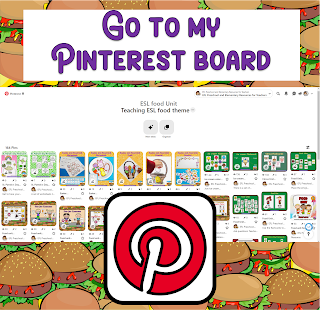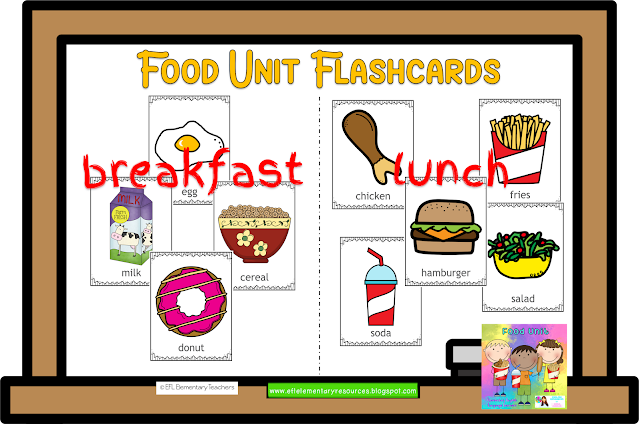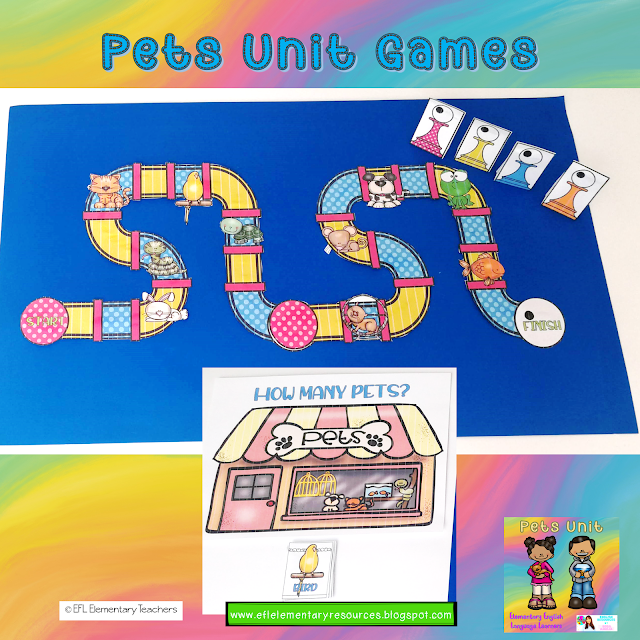This resource (Printable Food Unit worksheets for elementary ESL/ELL — fun reading, matching, writing, and speaking activities to practise food vocabulary and language structures) is part of the Food Unit Pack.
LINK: https://www.teacherspayteachers.com/Product/Food-unit-for-Elementary-English-Language-Learners-Starters-11035412Use the food unit worksheets as
a very cost-effective resource. If you don’t access to a lot of other active materials,
just print and copy for your class. If you want to cut cost even more, place
them in a clear plastic sheet and students write on them with a dry erase
marker and then erase with a napkin. So, check all the worksheets included in the resource to use with the diversity of students in your class.
There is a set of food unit vocabulary building worksheets to keep ESL students actively engaged.The vocabulary recognition worksheets are a way into guiding your learners to learn.
This set of food vocabulary worksheets for ELL will offer a hand-on way to reinforcing the new vocabulary even more for the very young learners. If the students cut them, they are cards to keep handy for writing or make them a matching game to play with classmates or at home.
These are the visual learning printable worksheets that involve drawing and more activities. They provide the opportunity for the students to draw the vocabulary words making a connection between them. Have the students draw the drinks as in the example, cut and paste on paper and then write sentences.Students will
draw on the worksheet as they express their creativity by illustrating the food
and drinks words. This will be an enjoyable practice activity leading to the retention
of the vocabulary.
Writing skills. Let’s use these worksheets as recapitulation
to review the previously unit taught units such
as the face. Reinforce the vocabulary and enhance the retention of those
concepts.
Have the students review the
family members as a way to consolidate the learning of that previous theme.
They will apply their knowledge of those words in a new context such as the
foods unit making connections between both units to express likes or dilikes.
These Reading comprehension with visuals and sentences worksheets will provide
your students with exposure to a variety of sentences
structures to contribute to language acquisition.
This can
also be a speaking activity. Ask the color of each number: What color is number 20?
Speaking practice with partner prompts. I love to include questionnaire
worksheets in all the resources of this Serie. This is where students put in use their linguistic competence with a simple directed dialogue. They encourage
the students to read a question to a classmate and have to write the answer. It
is a practice for paeaking, listening and writing. You can also graph results
on the board.
Graphing the favorite food. Do this one as a simple survey by placing the
options on the board, using the flashcards: pizza, hamburger, chicken, fries,
hot dog, salad. Create a bar graph on the board as they will come with their
worksheet and place it under their option bar. Tally the results.
Another
idea! Print some of the worksheets or all of them, bind and there you have got
a booklet. The cover is included. Preparing this or any booklet is a
ready-to-use resource at hand. The booklet keeps all exercises in one place,
making it easier to plan lessons sequentially.
Here
is my printable version of the booklet with a clear visual of what it looks
like. Students can use the booklet for extra practice at home. As students
complete the worksheets within the booklet, they can see their progress.
Prepare
your booklet and send me your pictures. I would love to see them. Here is a peek at mine.
Check my
Instagram Account for more freebies and resources: https://www.instagram.com/rosamelia_eslteacher/

























































